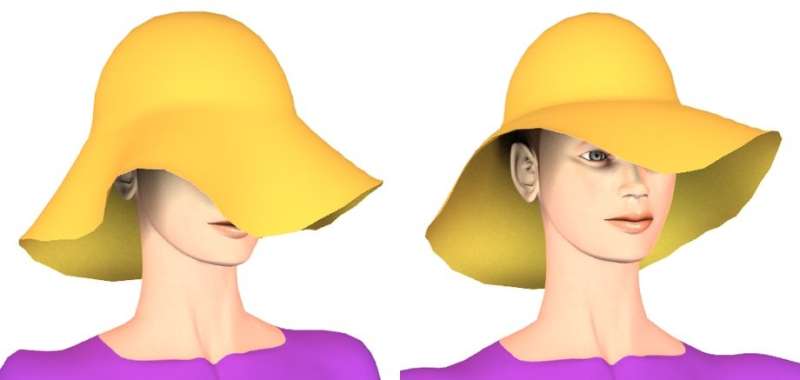New method automatically computes realistic movement with friction from 3-D design

Simulating any 3-D surface or structure—from tree leaves and garments to pages of a book—is a computationally challenging, time-consuming task. While various geometric tools are available to mimic the shape modeling of these surfaces, a new method is making it possible to also compute and enable the physics—movement and distortion—of the surface and does so intuitively and with realistic results.
Researchers from Inria, the French National Institute for computer science and applied mathematics, have developed a novel algorithm that computes the shape of the surface at rest, that is, without any external force, and when this shape is deformed under gravity, contact and friction, it precisely matches the shape the user has designed.
"Imagine you want to create a fancy garment on a 3-D character. With our method, you can freely design this garment directly in 3-D, around the character. You don't have to care about physics, but just about the shape, including the folds and wrinkles, that you would like to see at the final stage," explains Florence Bertails-Descoubes, scientific supervisor of the work and a researcher at INRIA. "Once you've completed the modeling, our algorithm automatically converts the geometric cloth into a physical one."
Users draw or design any 3-D surface utilizing their preferred geometric tools and can then turn to the new computational method to convert the surface into a physical object, and one that may or may not make contact with other surfaces. Bertails-Descoubes collaborated on the work with her Ph.D. students Mickaël Ly and Romain Casati and Inria colleagues Melina Skouras and Laurence Boissieux, and the team will present at SIGGRAPH Asia 2018 in Tokyo 4 December to 7 December. The annual conference features the most respected technical and creative members in the field of computer graphics and interactive techniques, and showcases leading edge research in science, art, gaming and animation, among other sectors.
Many geometric tools exist to perform accurate modeling of shapes with flexibility given to the user. Given the example of modeling clothing around a 3-D character, the researchers' method provides a simpler way for the clothing to mimic movement on the animated character, automatically computing for gravity and frictional contact with an external body.
"For instance, if a user draws a 3-D skirt on an animated character, our method will automatically shrink the rest shape and tighten it at the waist, to compensate for gravity which 'wants' to pull the item downwards," notes Bertails-Descoubes. The team's method also enables users to change the physical properties of the garment designed, i.e. making it out of linen instead of cotton. In turn, the cloth will behave differently, appearing softer, for instance, for lightweight cotton and will appear to have less friction with the body.
The scientists note that "the major difficulty in this kind of inverse problem stems from the fact that it is highly nonlinear. This complexity is particularly exacerbated by the presence of contact and dry friction, which was never explicitly accounted for in previous studies. It is thus challenging to design a robust algorithm able to find a valid rest shape for a large variety of different scenarios."
The researchers provided several examples in the paper, showcasing their algorithm's performance on 3-D animated designs. Included in the paper are two hat examples—noted as 'floppy hat' and 'beret'—which are posed on a human head through contact and friction. Without the researchers' inversion method, the floppy hat sags, completely losing its original style and partly covering the face of the animated character. In contrast, after running the new algorithm, the hat preserves its original style and realistically flip-flops with the movement of the character. The beret example produced similar realistic results after applying the team's method—the beret correctly remained inflated and posed on the head. When 'wind' is applied to the design, the beret slides with the movement but does not fall completely off the head, exemplifying the algorithm's ability to realistically simulate the physics involved.
In future work, the team will focus on making their algorithm work faster and be adapted to the creation of real garment patterns.
Provided by Association for Computing Machinery





















